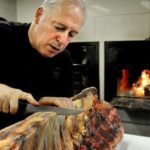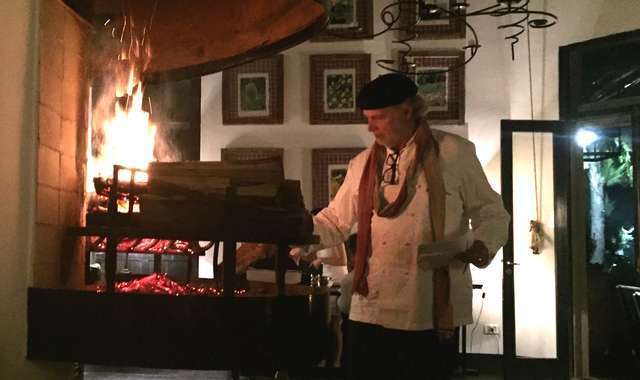By Sofia Perez
[Published by Zester Daily, June 1, 2016]
“Fire is a language all its own. It’s magical. Mysterious.” No, these are not the words of a committed arsonist, but rather Francis Mallmann, one of South America’s greatest chefs, a man famous for his deftness with this most elemental of cooking tools. Raised in Patagonia by an Argentinian father and Uruguayan mother, the 60-year-old Mallmann waxed poetic on the subject of fire when we sat down to talk at his Restaurante Garzón in the tiny Uruguayan town for which it is named.
Garzón is a curious place for a world-renowned chef to put down roots, but then Mallmann is a curious figure—part master craftsman, part culinary shaman. He opened his first restaurant in the Argentinian Andes at the age of 19 before moving northeast to set up shop in the Uruguayan beach resort of José Ignacio, a summer destination for the Argentinian upper crust. During the off-season, he staged in some of France’s most legendary kitchens, under the likes of Roger Vergé and Alain Senderens.
By the age of 40, he’d reached the top of his field, winning Le Grand Prix de l’Art de la Cuisine from the International Academy of Gastronomy, but instead of viewing the award as validation, he saw it as a wake-up call. “It made me sad. I’d forged a path through European cuisines, but I didn’t have my own culinary language.” In an effort to find it, he turned back to his childhood and began investigating the native cuisines of the Andes and other parts of South America.
A small town draws big names
His search led him to Garzón, a place he describes as having a wonderful aura. “It’s got great bones—the streets, the trees, the beautiful old houses. There’s a peaceful quality here.” He wasn’t the only one who saw the potential; I’d gone there in March as the guest of Bodega Garzón, a winery established by Alejandro Bulgheroni, an Argentinian oil tycoon who’s one of the world’s richest men.
To describe it as Uruguay’s most ambitious new winery isn’t saying much in a country smaller than Missouri that’s home to more cattle than people, but Bulgheroni’s $85 million project is not what you’d call a shoestring operation. Covering more than 520 acres, the complex includes a restaurant, a private wine club and an olive-oil production facility that resembles a modern Tuscan villa, and there are plans to build a boutique hotel amid the vines. Mallmann was brought in to help design the kitchens and create the menus.
As you’d expect from a project this ambitious, Bodega Garzón’s wines are anything but shabby. Indeed, they’re likely to gain this small but progressive country a closer look by international connoisseurs. In particular, the Albariño and Tannat bottlings are worth seeking out.
Although the winery is opulent, its restaurant menu is of a piece with the gaucho-inspired dishes Mallmann serves at his own place down the road. His food highlights the earthy flavor combinations, techniques, and ingredients (particularly the excellent meat) of Argentina and Uruguay, whose populations are a blend of indigenous and immigrant, the latter category hailing primarily from Italy and Spain. And running throughout Mallmann’s cuisine, always, there is fire.
No translation necessary
His favored medium notwithstanding, however, Mallmann brings to his food an undeniable delicacy—fire as perfume, not punishment. “People think that cooking with fire is a masculine thing, something brutal, but it’s actually quite fragile.”
He made his case at the dinner he hosted for the winery’s official opening. In the square outside his own restaurant, Mallmann and his team spent the day tending to a split-leveled fire that was surrounded by a circle of crucified lambs, which were themselves ringed by flames. By the time guests arrived that evening, the darkness of rural night had been deferred, revealing a tableau that suggested an offering to the gods—or a scene from Lord of the Flies, take your pick. But despite the fierce manner in which the meat had been cooked, it remained remarkably tender, and its subtle flavor was surprising.
“The ‘simple’ approaches are the most difficult,” said Mallmann, “because there’s nowhere to hide. Things can go wrong with the tiniest shift.” He pointed to the strong winds that had buffeted Garzón that day, constantly altering the fire’s temperature and, therefore, the way the meat cooked. Mastery of such a technique can only be achieved through repetition and attentiveness. “The language of cooking is one of silences—it’s of the hands and all the senses.”
Throughout our conversation, Mallmann returned repeatedly to the metaphor of language, which seems fitting for someone who has used cooking to communicate with people all over the world. “If you bring a president and a farmer together around a fire, you don’t need words,” he said. “Fire is part of our collective memory—it’s what unites us.”
RECIPE: Tomato, Goat Cheese and Anchovy Bruschetta
Excerpted from Seven Fires by Francis Mallmann (Artisan Books, 2009).
According to Mallmann, the key to this recipe is to burn the tomatoes to achieve a “toasty bitterness” that contrasts with the sweetness of the liquid they contain.
Ingredients
36 cherry tomatoes (about 1 pound)
1/2 cup fresh oregano leaves
1/4 cup extra virgin olive oil
Coarse salt and freshly ground black pepper to taste
1 day-old baguette (10 ounces) sliced into 24 half-inch-thick rounds, toasted until crisp
8 ounces Bûcheron or similar goat cheese
24 anchovy fillets (about 3 1/2 ounces), drained and halved lengthwise
Parsley, Olive Oil and Garlic Sauce (see recipe below)
Directions
Cut the tomatoes in half and put them in a bowl. Add the oregano, olive oil and salt and pepper to taste. Toss to combine.
Heat a chapa or large cast-iron griddle over very high heat. When it is very hot, place the cherry tomato halves cut side down about 1 inch apart on the hot surface; work in batches if necessary. It is very important not to move the tomatoes while they cook, or they will release their juices and lose their shape and texture. Keep in mind that it is hard to char a tomato too much: best to err on the side of charring; and if you do move one, you are committed and you should remove it immediately. When you see that the tomatoes are well charred on the bottom, almost black (about 4 minutes), remove them using tongs or a spatula and place burnt side up on a large tray, about an inch apart so they don’t steam.
Arrange the toasted bread rounds on a platter. Spread some of the goat cheese on each round, and place 3 tomato halves on top of the cheese. Garnish with the anchovies and drizzle a teaspoonful of the sauce on top. Serve immediately.
Parsley, Olive Oil, and Garlic Sauce
Excerpted from Seven Fires by Francis Mallmann (Artisan Books, 2009).
Ingredients
1/2 cup packed minced fresh flat-leaf parsley
1 teaspoon minced garlic
1/2 cup extra virgin olive oil
Coarse salt and freshly ground black pepper to taste
Directions
Combine the parsley and garlic in a small bowl. Slowly add the olive oil, whisking to combine. Season to taste with salt and pepper. The sauce can be kept refrigerated for three to four days.



